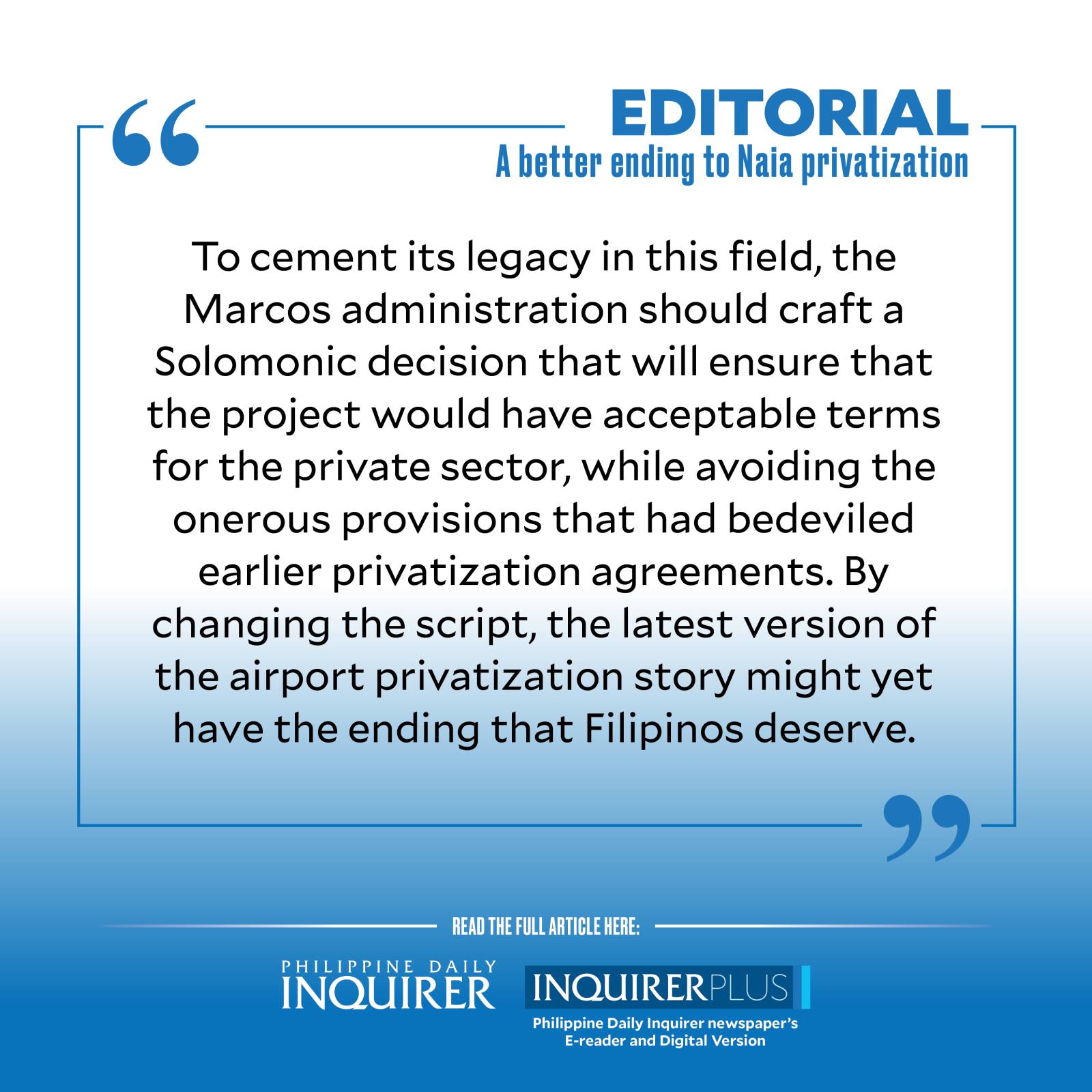A better ending to Naia privatization

Last week, the Marcos administration formally kicked off the process of transferring to private hands the rehabilitation, operation, and maintenance of the Ninoy Aquino International Airport (Naia), the country’s main gateway notorious for being congested and prone to massive disruptions.
The Department of Transportation (DOTr) and the Manila International Airport Authority (MIAA) have given interested parties until Dec. 27 this year to submit their bids for the P170.6-billion project, which aims to almost double Naia’s current passenger capacity of 32 million within the concession period of 15 years, extendable by another 10. The solicited Naia public-private partnership (PPP) project includes the long-awaited rehabilitation of passenger terminals and runways and the installation of new facilities to improve overall passenger experience.
The plan certainly looks good on paper, but the question on everyone’s mind remains: Will this latest version of the Naia privatization program finally succeed? Or will it meet the same fate as previous attempts to get the private sector to take over this airport that this year was named the eighth worst in Asia based on passenger queueing time, and the third most stressful in Asia last year?
The cynicism is well-founded, given several failed attempts at privatization from the time the idea was first broached during the term of President Fidel Ramos in the 1990s. More recently in 2018, the Duterte administration awarded the original proponent status to a Naia “superconsortium” composed of seven of the country’s biggest conglomerates, which proposed to invest P102 billion to upgrade the aging airport over 15 years. While the group submitted a revised proposal in 2019, the project died a natural death in March 2020 over “unresolved issues” with the government.
Another proposal, from Megawide Construction Corp. and its partner GMR Infrastructure Ltd.—the main proponents behind the development of the acclaimed Mactan International Airport in Cebu—was eventually rejected in December 2020, with the government claiming that the group lacked the financial capacity to pursue the massive project.
The Marcos administration saw another unsolicited offer to upgrade the airport from yet another superconsortium participated in by five of the six conglomerates involved in an earlier failed bid. Included in its bid was a P57-billion upfront concession payment said to be the “largest ever” for a transportation PPP project in the country.
The proposal by the Manila International Airport Consortium (MIAC) to significantly improve the operations and maintenance of the airport for P267 billion over a concession period of 25 years, however, was set aside in favor of the current bid terms that the government believes to be the more ideal route to take. The Marcos administration may have reason to be optimistic that these terms would attract experienced and deep-pocketed private sector partners, given that air travel continues to recover after the devastating pandemic.
“We think multiple bids will be submitted despite the requirements because the Naia rehabilitation project remains a solid investment proposition for various local and foreign infrastructure firms,” said Infrawatch PH convener Terry Ridon. “Until the Bulacan airport is built, it remains the nation’s premiere international gateway, and it is the closest airport to the capital’s financial, political, and cultural hubs,” he added. San Miguel Corp.’s Bulacan airport project, which is currently undergoing land development works, is targeted to be completed by 2027.
DOTr Undersecretary for Aviation and Airports Roberto Lim, meanwhile, said that he expects the Naia privatization contract to be awarded as early as the first quarter of next year, providing long-suffering airport users some relief. While the MIAC, whose proposal had been rejected, has yet to say if it would join the solicited bidding process, it has said that it was “one with the government on its infrastructure priorities” and was aligned with the commitment to revitalize Naia. It added: “Regardless of the route, we firmly believe that Naia’s modernization requires a long-term and comprehensive solution delivered by a credible and capable party at the quickest possible time. These criteria—regardless of the approach—would best benefit Naia and the Filipino people.”
Indeed, Filipinos can no longer afford to wait to see significant improvements at Naia and an end to glitches over the past two years that had led to the grounding of hundreds of flights. To prevent a repeat of the unfortunate ending in past attempts, the DOTr and the MIAA must carefully study what led to negotiations falling through, from protracted negotiations that led nowhere to the mindset that prevented the entire project from being viable in the first place.
To cement its legacy in this field, the Marcos administration should craft a Solomonic decision that will ensure that the project would have acceptable terms for the private sector, while avoiding the onerous provisions that had bedeviled earlier privatization agreements. By changing the script, the latest version of the airport privatization story might yet have the ending that Filipinos deserve.
















